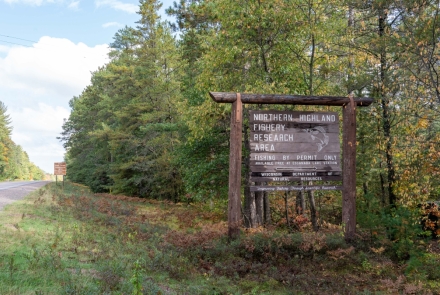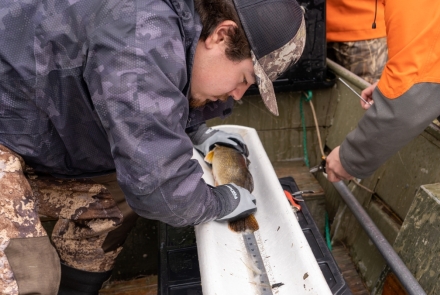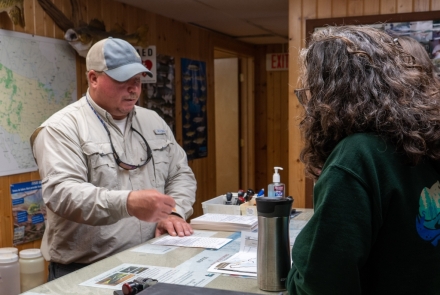About The Northern Highland Fishery Research Area
A Fisheries Research Legacy
The Northern Highland Fishery Research Area, formerly known as the Five Lakes Research Project, was established by the Wisconsin DNR (then the Wisconsin Conservation Commission) in 1946 as experimental fisheries research lakes. Located near Boulder Junction, Wisconsin, the Northern Highland Fishery Research Area is nestled in the Northern Highland-American Legion State Forest, among a landscape that is classic Wisconsin Northwoods.
The five lakes selected for the Northern Highland Fishery Research Area include Escanaba, Nebish, Pallette, Spruce, and Mystery lakes. These lakes represent the different types of lakes and fisheries found in Wisconsin, ranging from deep, cold and clear Pallette Lake to shallow, boggy and warm Spruce Lake. The undeveloped shorelines and limited accessibility to some of the lakes have made them ideal for research and for anglers to find a peaceful area to fish.
These lakes have been intensively monitored and continuously managed as experimental fisheries research lakes in addition to a compulsory creel survey of all anglers who fish the Northern Highland Fishery Research Area, collecting data on angler demographics, how they fished and the fish they caught. Over the years, numerous research studies have been conducted by the DNR and multiple universities on a variety of topics, including:
- fisheries regulations
- effects of stocking
- angler habits and effects on fish populations
- fish biology
- fish feeding habits
- fish species interactions
- chemical treatment of small lakes with unbalanced fish populations
One of the most valuable outcomes of the Northern Highland Fishery Research Area has been the collection and maintenance of several long-term databases; angler harvest on all five lakes has been continuously monitored since 1946 and is one of the longest such records of compulsory creel data in the world. This dataset monitors angler behaviors over time and helps us understand how changing practices influence Wisconsin fisheries. The creel survey data also helps document how species-specific regulations influence the sustainability of that species and the larger fish community, helping screen regulations before they are applied to other Wisconsin lakes.
The Northern Highland Fishery Resarch Area also serves as a training ground for the development of fisheries professionals who continue this fisheries research legacy. The Northern Highland Fishery Research Area field program of fyke netting, electrofishing, gill netting, standard limnological sampling and overall field fisheries techniques offers unique hands-on experiences for early-career professionals that may not be possible in larger-group classroom settings. Diverse research opportunities set students and young professionals on a pathway to success early in their fisheries research careers.
For more Northern Highland Fishery Research Area history, check out this article by DNR staff:Sass, G.G., S.L. Shaw, and K.M. Renik
Key Findings:
- Reviews the 75-year history of the Northern Highland Fishery Research Area
- Discusses the Northern Highland Fishery Research Area as a training ground for early career fisheries professionals and speculates on its future
- Highlights the importance of adaptation, long-term data, establishing sentinel lakes for observations of environmental change, field stations, and partnerships for successful fisheries management
IMPROVING FISHING THROUGH SCIENTIFIC RESEARCH
How can we better understand regulation and harvest influence on Wisconsin’s fish populations? There are a lot of factors in natural fish population size, reproduction and recruitment, and they vary wildly. The only effective way to measure natural variability in fish populations is by studying them for a long period of time. The long-term monitoring and research on Northern Highland Fishery Research Area lakes will continue to increase our understanding of this variability, learning from data collected over the past several decades and from additional research on the lakes.
This is especially important because there is an increasing need for multi-species and ecosystem management in Wisconsin. Intensive harvest and management of key species such as walleye may have significant influences on the entire fish community. Research on Northern Highland Fishery Research Area lakes will continue to address these issues by evaluating various species interactions such as walleye-yellow perch, smallmouth bass-yellow perch and walleye-muskellunge.
Thanks to the dedication of scientists, biologists, technicians, conservationists and anglers, the Northern Highland Fishery Research Area has been improving fishing through scientific research for over 75 years. This valuable dataset and the research conducted in Northern Highland Fishery Research Area lakes help us study angler habits, fish populations, and how they affect each other over time—and, in turn, provide applicable research to make informed fisheries management decisions that keep Wisconsin fisheries thriving.
HOW IT WORKS
All anglers, before fishing, are required to obtain a free permit at the DNR check-in station by Escanaba Lake and are required to return the permit at the conclusion of their trip or by the end of fishing hours. Permits are required to fish the five lakes in the Northern Highland Fishery Research Area, and anglers must check out at the end of the day—this ensures accurate data is being collected for the Northern Highland Fishery Research Area dataset. At check-out, staff will chat with you about your trip, collecting information such as time spent fishing, fishing methodology, and targeted species. They will also record all catch-and-release and harvested fish information.
For more information on the check station, hours, fishing regulations and individual lake information, please see Fish The Northern Highland Fishery Research Area webpage.




